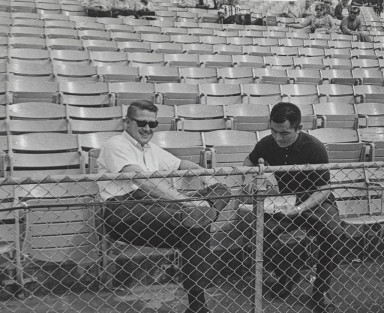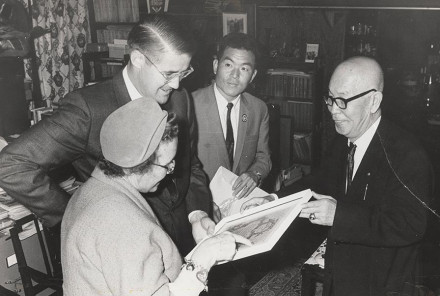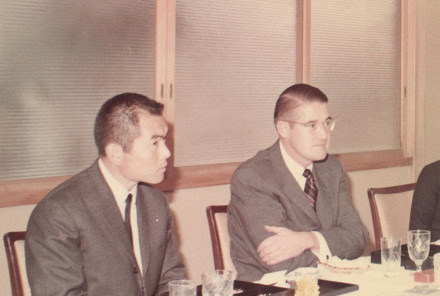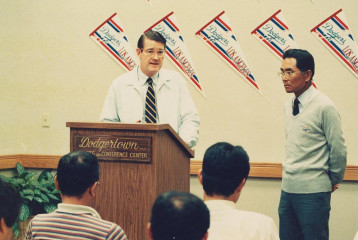Ike Ikuhara: From Dodgertown to the Japan Baseball Hall of Fame
By Robert Schweppe
Even if you were an early riser, Ike Ikuhara was always up earlier than anyone at Dodgertown, Vero Beach, Florida.
He would finish his early morning run and read his newspapers before people were waking up. But then, he had a lot to accomplish.
Akihiro “Ike” Ikuhara arrived in Dodgertown in March, 1965. He knew no one there, spoke few English words, his wife Kimiko and young son were in Japan, but he was willing to do whatever it took to learn and work for the Los Angeles Dodgers. And in time, he became one of the most remarkable and likeable persons in the Dodger organization and one of the most honored. No other person in Major League Baseball history has ever done what Ike did in his career. His life story is one of tremendous dedication, effort, and diligence.
In January, 2002, Harry Missildine, a sportswriter for the Moscow-Pullman Daily News, who knew Ike when he worked in Spokane, Washington in 1965-1966, wrote of Ikuhara’s election to the Japan Baseball Hall of Fame and described him as “A cheery, good-looking, smart, enthusiastic young man. Ike’s respect and love of the game was profound.”
Nothing came easy for Ike. As a young man educated at prestigious Waseda University in Tokyo and with a current job and family, he politely requested to Sotaro Suzuki, a Japanese sports columnist who would be elected to the Japan Baseball Hall of Fame, to introduce him to Walter O’Malley. Suzuki refused Ike’s request three times. However, over time, Ike’s patience, talent, and dedication won over Suzuki and the author agreed to endorse him to O’Malley.
Suzuki’s letter of February 8, 1965 to Dodger President Walter O’Malley begins, “I have met a very young promising man who has recently come to me and my home quite often to become a good friend through baseball.” Suzuki writes of Ike’s background with Waseda and coaching the baseball team at Asia University. Suzuki writes a glowing report of Ike’s desire. “So far I have observed his actions in the camp (an instructional camp conducted by Tommy Lasorda and Dodger scout Kenny Myers) and have known Ikuhara to be an alert, earnest, and a very hard worker.” Suzuki makes a prediction on Ike’s chance. “I am sure he shall be a good help to your organization some days in the future.” These words changed baseball in the U.S., Japan, and around the world.
Seeing his diligence to every task he put himself toward, he was hired on a trial basis to work in Dodgertown in March, 1965.

Peter O’Malley and Akihiro “Ike” Ikuhara at Holman Stadium, Dodgertown, Vero Beach, Florida circa 1965. Ikuhara started his Dodger baseball executive career at Dodgertown in the spring of 1965.
He won everyone over quickly with his desire and thoroughness. If the question arose, “What does Ike do for the Dodgers?” the answer might be more like, “What didn’t he do?” To learn as much as he could about the Dodgers and American baseball, no one could outwork him. He took on every available task assigned and did it well on the Dodgertown base.
Walter O’Malley decided Ike would best realize his dream of learning the business side of the baseball industry. His recommendation was that Ike would begin his career to accompany Peter O’Malley to Spokane, Washington where Peter would run the Dodgers’ Triple-A club in 1965.
Ike worked hard to improve his English in Spokane. But, ballplayers being ballplayers, they were helping Ike to learn English, but as Ike said, “All the wrong words.”
Ike was a yearly employee to Dodgertown and thrived on the seven-day week with long hour days for Spring Training. In 1967, when Peter O’Malley became the Vice President of Stadium Operations for the Dodgers, he wanted Ike to advance with him to Dodger Stadium. There, Ike became invaluable to the entire organization in stadium operations, marketing, publicity, community work and the minor league department. His thirst for baseball knowledge had no end.
With their employment of Ike, Walter and Peter O’Malley would set new ground for baseball to become an international game, benefiting Major League Baseball and all other countries.
Ike accompanied the Dodgers on their Goodwill Tour Series to Japan in 1966 and was very helpful in the relationship. Ike served as host to the Tokyo Yomiuri Giants when they made their trips to Dodgertown to conduct pre-season activities. He translated so well that every person with the Giants staff felt comfortable in the training atmosphere there. Ike would painstakingly write the Dodgertown regulations and breakfast, lunch, and dinner menus in Japanese for the Giant players and staff in the Dodgertown dining room.

During Dodgers’ 1966 Goodwill Tour to Japan, (L-R): Kay O’Malley; Peter O’Malley; Japan Baseball Hall of Fame executive Akihiro “Ike” Ikuhara; Japan sports columnist Sotaro Suzuki, member of the Japan Baseball Hall of Fame.

Akihiro “Ike” Ikuhara (left) and Dodger President Peter O’Malley are in Tokyo in late October for the 1970 Japan Series between the Tokyo Yomiuri Giants and the Lotte Orions. The Los Angeles Times reported that fall that O’Malley is the first official of a Major League Baseball team to attend the Japan Series.
Working directly with Peter O’Malley, Ike was regularly involved in projects involving international baseball. In 1980, when the Dodgers purchased the world’s largest video board called “Mitsubishi Diamond Vision” that significantly changed sports and the in-stadium fan experience, Ike was a member of the executive group that helped seal the agreement. He was a regular commentator for NHK when the World Series was broadcast to Japan. Ike accompanied Peter O’Malley on numerous trips to Japan to meet with team owners, league presidents and prominent others in the baseball industry every time he visited. Kimiko Ikuhara, Ike’s wife, published a book on Ike’s life after his passing in 1992, with the title, “The Man Who Married the Dodgers.” With his great smile, Ike would have agreed with his wife’s title of the book. Ike was a baseball author himself, writing two books, including one in 1985 about the Dodgers titled, “A Winning Tradition!”
As President of the Los Angeles Dodgers, O’Malley was at the forefront to urge the Los Angeles Olympic Organizing Committee to include the sport of baseball. He called upon Ike to become a diplomat for Olympic baseball, and Ike succeeded tremendously. The goal was to make baseball a permanent gold medal sport in the Olympic Games. Countless hours were put into travel, meetings, discussions, phone calls, and encouragement by Ike to countries around the world interested in baseball. He had all the requisites for the delicate mission: dedication, thoroughness, intelligence, listening and communication skills, character, and the ability to devise and execute a plan to include all interested countries.
Wasting no time, Spring Training in Dodgertown became an appropriate meeting place for baseball dignitaries to visit Dodger President Peter O’Malley and Ike and to give their input on how to realize the Olympic dream of baseball. Finding ways to create time in a crowded Dodgertown schedule, Ike handled everything deftly.
In 1982, O’Malley named Ike as Assistant to the President. That fall, O’Malley’s faith in Ike’s skills were such Ike traveled to Moscow alone to meet with the Soviet Minister of Sports there to encourage a vote for baseball in the Olympics. O’Malley’s friend, Dr. Shigeyoshi Matsumae, founder of Tokai University in Tokyo, sent a letter to O’Malley which he gave to Ike to hand carry to the Soviet Union Minister of Sports. The letter was to encourage support for baseball as a gold medal sport in the Olympic Games. When Ike met with the Soviet Minister of Sports Sergei Pavlov on October 7, 1982, it marked the historic first time baseball in the Western Hemisphere made official contact with the Soviet Union.
And in 1984, in an incredibly successful tournament won by Japan, Olympic Baseball was played as an eight-team exhibition tournament during the Games of the XXIII Olympiad in Los Angeles. Dodger Stadium averaged nearly 50,000 fans each day and had the third highest attendance for any sport in Los Angeles behind track and field and gymnastics.
Peter O’Malley was opening doors for other countries to improve their baseball players and the game. And Ike was always a part of that. When Dr. Matsumae wished to build a baseball field in Moscow, Peter and Ike were there for the groundbreaking and the eventual dedication.
Ike’s business management performance was gaining notice and several times he was offered positions as the president for professional baseball teams in Japan. His loyalty to the O’Malleys and the Dodgers were always strong enough incentives for him to remain. He never regretted his decision to stay in Los Angeles and be with the Dodgers.
Ike was prominent in Peter O’Malley’s efforts to privately build the first baseball field in the People’s Republic of China. Traveling alongside O’Malley on several trips to China, Ike met regularly with Sports Ministers and other government leaders. In September, 1986, Dodger Baseball Field opened at the Tianjin Institute of Physical and Cultural Education and Ike was present to celebrate.

Dodger President Peter O’Malley is in Moscow, Russia for groundbreaking ceremonies for the first field dedicated solely to baseball in Russia, privately constructed by Dr. Shigeyoshi Matsumae, founder of Tokai University, Tokyo. O’Malley is joined by his longtime assistant Akihiro “Ike” Ikuhara on the trip starting April 17, 1988 and they stand next to an artist’s rendering of Matsumae Baseball Stadium. O’Malley and Ikuhara returned for the dedication ceremonies of Matsumae Baseball Stadium on September 1, 1989 on the campus of Moscow State University, Lenin Hill.

While Japan’s professional Chunichi Dragons are training at Dodgertown, Vero Beach, Florida, two baseball coaches from Russia — Alexander Ardatov and Gela Cheehradze — are introduced at a press conference held by Dodger President Peter O’Malley. Interpreting for the Japanese media is Akihiro “Ike” Ikuhara next to O’Malley, his longtime assistant. Dodgertown was the site of numerous cultural and international baseball exchanges.

October, 1989
(L-R) Sadaharu Oh; Peter O’Malley; Ike Ikuhara
Japan Hall of Fame legend Sadaharu Oh greets Peter O’Malley and Ike Ikuhara as they attend the 1989 Japan Series. The Giants lost the first three games of the series and then won four straight games for the Japan Series title. Oh was not manager of the Giants but dressed in uniform as a coach and instructor.
He continued to make contributions to the baseball world. Ike became a mentor to a struggling young pitcher from Japan, Masahiro Yamamoto. In Dodgertown, in the heat of the summer of the Florida State League, Ike taught Yamamoto to throw a screwball. His confidence restored, Chunichi Dragons prospect Yamamoto returned to Japan and became one of the great pitchers in Japan baseball history. Yamamoto pitched in the Japan professional leagues until he was 50 years old and won more than 200 games in his career. Yamamoto honored the memory of Ike by traveling to Dodgertown, Vero Beach, Florida to pay tribute to his coach after Ike’s passing. In 2022, Yamamoto was inducted into the Japan Baseball Hall of Fame.
Ike passed on October 26, 1992 after serving as assistant to Dodger President Peter O’Malley for 10 years, and 27 years in the organization.
Reporter Dwight Chapin interviewed Ike in 1969 for the Los Angeles Times, and Ike expressed his appreciation to work in baseball. Ikuhara said, “The main people in my life I have to thank are Mr. (Sotaro) Suzuki and the O’Malleys. And as far as the O’Malleys go, I just can never repay them, except to do what I can in whatever way I can for the team.”
O’Malley said, “The longtime friendships with Japan, dating back to 1956, plus other exchanges that worked successfully, gave the Dodgers a positive reputation and helped with the historic signing of Hideo Nomo.” Nomo went on to win the 1995 National League Rookie of the Year. From that signing by the Dodgers and O’Malley, more than 65 Japan-born players, including Ichiro Suzuki and Shohei Ohtani (through the 2023 season) have come to play baseball in the United States, encouraging players from many countries to do the same.
Ike was elected to the Japan Baseball Hall of Fame in 2002, the only time this honor has ever been accorded to a USA Major League Baseball executive. He was recognized for his efforts to build bridges from the United States to Japan. Historic Dodgertown later included his photo on the Hall of Fame Wall at Holman Stadium, the achievement of all Hall of Famers who have ever appeared there.

Dodger President Peter O’Malley with Dodger Manager Tommy Lasorda during the 1993 Dodgers Friendship Series in Fukuoka, Japan. Lasorda and the Dodgers wore a special rectangular black patch with the name “IKE” to commemorate O’Malley’s longtime assistant Akihiro “Ike” Ikuhara, who passed on October 26, 1992. The Dodgers played three exhibition games in Taiwan, the first MLB team to play in Taiwan, and two exhibition games against the Daiei Hawks and Tokyo Yomiuri Giants combined teams in Fukuoka, Japan.

Akihiro “Ike” Ikuhara postcard from the Japan Baseball Hall of Fame. Ikuhara was inducted into the Hall of Fame posthumously in 2002 (July 12, 2002). Ikuhara is the only USA executive from MLB to have been inducted in Japan.
The Dodgers wore an “Ike” patch on their uniform sleeve during their 1993 Friendship Series games in Taiwan and Japan. And in 2003, O’Malley instituted the Ike Ikuhara and Peter O’Malley Memorial Sports Management Class at Ike’s alma mater, Waseda University. There, two U.S. Presidents, a former Secretary of State, and Japan Hall of Famer Sadaharu Oh spoke during a six-year span.

Dodger President Peter O’Malley speaks at the memorial service for Akihiro “Ike” Ikuhara on January 27, 1993 in Tokyo, Japan. Ikuhara began his career with the Dodgers in 1965 and continued until his passing on October 26, 1992. He served as Assistant to the President from 1982-1992. Ikuhara is the only Major League Baseball executive to be inducted into the Japan Baseball Hall of Fame.
And at the former Dodgertown, his second home, the Holman Stadium photo wall of Japan and National Baseball Hall of Famers, includes Ike, and he has his same great smile as he sits in a seat that overlooks his favorite place in the background, Dodger Stadium.

